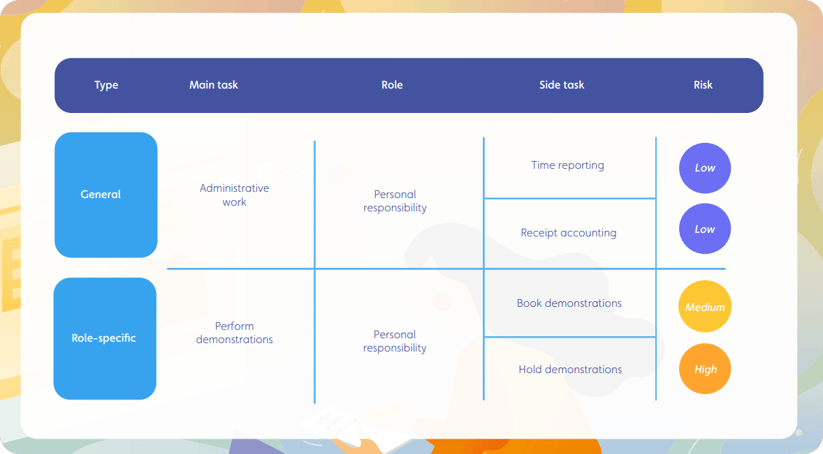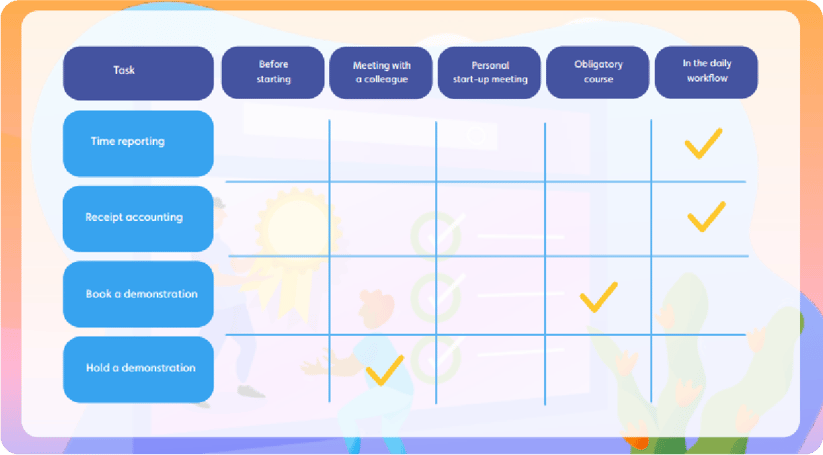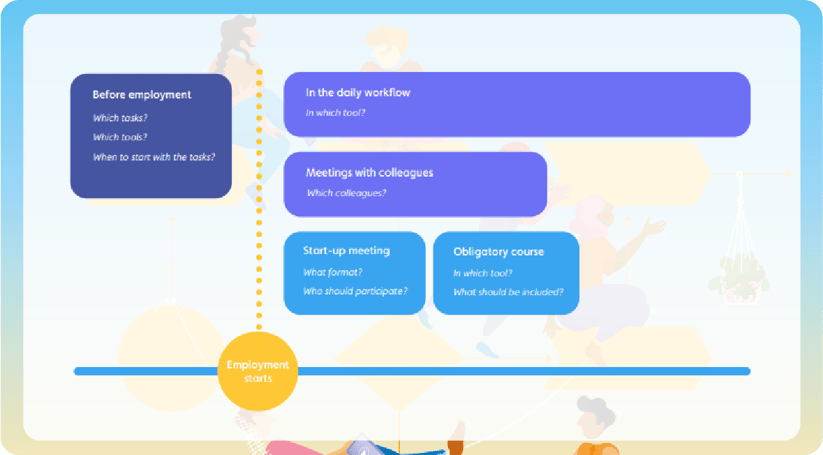We all know how overwhelming it can be to be newly hired. There are many new things to be learned simultaneously, both in terms of knowledge and work environment. Many feel knocked out by the end of the day. Learning so many different things at the same time is not optimal. We can see a need for a well-thought-out process to learn the right things at the right time.
We have summarized this into three simple steps. With these, you can create a structured onboarding which makes it easier for the newly hired to understand and for the employees to learn from them.
1. Map what the new employee shall do
After the contract is signed, it is time to consider onboarding the new colleague. In our method, this means to start mapping what the new employee shall do.
It might seem logical to think of what the new employee should know, but it is easier to create an efficient onboarding process based on what the newly employed shall do.

Example of how a mapping of tasks can look like.
Divide the mapping into general and position-related tasks. The "general tasks" include what all employees have to know, like understanding the company's goals and performing administrative work. The position-related tasks are necessary for a specific position, for example, performing demos as a salesperson.
Divide the main tasks into subtasks to make it easier for the newly hired to, by themselves, understand and embrace these.
To understand what tasks are important to know, you rank them. It is also essential to consider the employee's responsibility for each task - whether it is a primary responsibility or a responsibility shared with others.
2. Categorize learning
When the tasks are mapped, they have to be categorized into the correct type of content to give the right type of learning under the right conditions and context.
Before starting
It is advantageous to become introduced to the company and the new colleagues before the first day at work.
Meeting colleagues
Å møte arbeidskollegaene som allerede er i etablerte stillinger, handler ikke bare om å forstå arbeidsoppgavene og hvordan avdelingene jobber, men også om å skape relasjoner.
Meeting colleagues is not only about understanding your tasks and how the departments are working, but also about creating relations.
One-on-one startup meeting
A meeting with the nearest manager is good for discussing formalities like work description and expectations on both sides.
Mandatory courses
For arbeidsoppgaver som er viktige og må sertifiseres, er det bra med kurs. De er enkle å følge opp og vurdere resultater.
Courses can be good for tasks that are important and need certifications. It is easy to follow up on and evaluate results.
Daily work
Når man støter på utfordringer i forskjellige systemer er det bra om støtten er tilgjengelig akkurat der og da når medarbeideren trenger det. Da er det viktig at verktøy som er tilpasset slike situasjoner, tas i bruk.
It is good if support is available when and wherever the employee needs it when bumping into challenges in different systems. Then it is advantageous to use tools adapted to that kind of use.

Example of how work tasks are connected to appropriate content.
3. Plan the implementation and allocate resources
After all the work tasks for the newly hired are mapped and categorized into learning needs, it's time to plan the content. Who is in charge of each occasion, and when shall it happen?
 Timeline to plan the learning needs.
Timeline to plan the learning needs.
Creating a timeline makes it easy to get an overview and understand the interaction between the different learning needs. Start by determining when things should be implemented and who is in charge. Meetings with other employees are often more manageable for the newly hired to set up themselves.
It is essential to use the right tools, adapted to the different tasks. Mail is often enough before start-up, but to maintain delivering the right help in the right place in the workflow, you need a system made for this. For this, a system like InfoCaptions Performance Support-solution context help is very suitable


